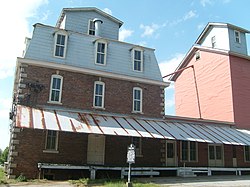
Salisbury is a city in the Piedmont region of North Carolina, United States; it has been the county seat of Rowan County since 1753 when its territory extended to the Mississippi River. Located 25 miles (40 km) northeast of Charlotte and within its metropolitan area, the town has attracted a growing population. The 2020 census shows 35,580 residents.
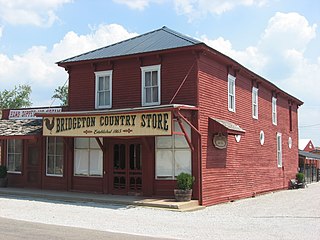
Bridgeton is an unincorporated community and census-designated place in Raccoon Township, Parke County, in the U.S. state of Indiana. It is notable for its covered bridge, which was destroyed on April 28, 2005, by a fire set by an arsonist. A historically accurate reconstruction of the bridge was completed in October, 2006.

Salisbury National Cemetery is a United States National Cemetery located in the city of Salisbury, in Rowan County, North Carolina. It was established at the site of burials of Union soldiers who died during the American Civil War while held at a Confederate prisoner of war camp at the site.
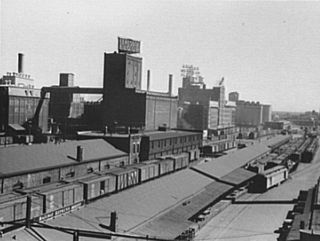
Northwestern Consolidated Milling Company was an American flour milling company that operated about one-quarter of the mills in Minneapolis, Minnesota, when the city was the flour milling capital of the world. Formed as a business entity, Northwestern produced flour for the half-century between 1891 and 1953, when its A Mill was converted to storage and light manufacturing. At its founding, Northwestern was the city's and the world's second-largest flour milling company after Pillsbury, with what is today General Mills a close third. The company became one of three constituents of a Minneapolis oligopoly that owned almost nine percent of the country's flour and grist production and products by 1905. This occurred as a result of their attempt at a United States monopoly.

Cleveland Township is one of fourteen non-functioning county subdivisions (townships) in Rowan County, North Carolina that were established in 1868. The township had a population of 2,817 according to the 2010 census. The only incorporated municipality in Cleveland Township is the town of Cleveland. Residents are served by the Rowan–Salisbury School System and the township is home to Mt Ulla Elementary School.

This list includes properties and districts listed on the National Register of Historic Places in Rowan County, North Carolina. Click the "Map of all coordinates" link to the right to view an online map of all properties and districts with latitude and longitude coordinates in the table below.
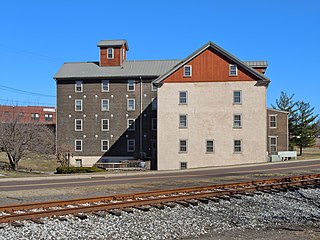
The Pottstown Roller Mill is an historic, American roller mill that is located near the Schuylkill River in Pottstown, Montgomery County, Pennsylvania.

The Fulton–Mock–Blackmer House is a historic home built in 1820 in Salisbury, North Carolina, USA, whose most famous resident was the actor Sidney Blackmer. It was severely damaged in a 1984 fire, then left largely neglected for nearly three decades. A full restoration was completed in 2015. It is located in the West Square Historic District, created by the city in 1975, and is a contributing structure to the Salisbury Historic District.
The Rowan Museum is located in a 19th-century courthouse in Salisbury, North Carolina that survived Stoneman’s Raid. The building is considered to be one of the finest examples of antebellum architecture in North Carolina. The museum is dedicated to the history of Rowan County.

The Neligh Mill is a water-powered flour mill in the city of Neligh in the northeastern part of the state of Nebraska in the Midwestern United States. The mill was built in 1873 by John Neligh, the city's founder, to make use of water power from the Elkhorn River. It operated for nearly one hundred years until it closed in 1969.

Grimes Brothers Mill, also known as Lexington Roller Mill and Excelsior Mill, is a historic flour mill located at Lexington, Davidson County, North Carolina. It was built about 1885, and is a four-story brick building with a basement. It measures approximately 34 feet by 40 feet and has a shallow-pitched shed roof. The mill remained in operation until about 1960, and the building was converted to bank use in the early 1960s.
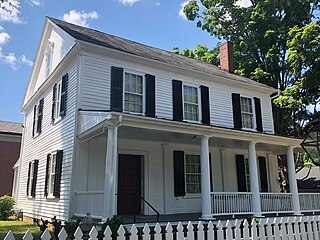
Maxwell Chambers House is a historic home located at Salisbury, Rowan County, North Carolina. It was built between 1814 and 1819, and is a two-story, three-bay, Federal-style frame townhouse. It has three interior end chimneys and a one-story full-width shed roofed front porch with Doric order columns.

The Josephus Hall House, also known as the McNeely–Strachan House and Salisbury Academy, is a historic home located at Salisbury, Rowan County, North Carolina, United States. It was built about 1820, as a two-story, frame dwelling. It was remodeled in the 1850s to add its distinctive two-tier flat roofed front porch. The porch features a five bay ornamental cast iron arcade in a grapevine pattern. The roof was modified to the hipped roof form and exterior chimneys rebuilt in 1911. The interior has Federal, Greek Revival, and Late Victorian-style design elements. The building housed the Salisbury Academy girls' school from about 1820 to 1825.

The Walter McCanless House, also known as the Hedrick House or Donaldson House, is a historic home on Confederate Avenue in Salisbury, Rowan County, North Carolina, and was completed in 1929. The building was listed in the National Register of Historic Places in 2005.

North Long Street–Park Avenue Historic District is a national historic district located at Salisbury, Rowan County, North Carolina. The district encompasses 46 contributing buildings in a predominantly residential section of Salisbury. It was developed largely between about 1890 and 1925, and includes notable examples of Gothic Revival, Colonial Revival, and Bungalow / American Craftsman style. It was listed on the National Register of Historic Places in 1985.
Salisbury Historic District is a national historic district located at Salisbury, Rowan County, North Carolina. The district encompasses 348 contributing buildings and 1 contributing site in the central business district and surrounding residential sections of Salisbury. It includes notable examples of Late Victorian, Colonial Revival, and Bungalow / American Craftsman style architecture. Located in the district are the separately listed Maxwell Chambers House, McNeely-Strachan House, Archibald Henderson Law Office, and the former Rowan County Courthouse. Other notable buildings include the tower of the former First Presbyterian Church (1891-1893), Rowan County Courthouse (1914), Conrad Brem House, Kluttz's Drug Store, Bell Building, Washington Building, Grubb-Wallace Building, Hedrick Block, Empire Hotel, St. Luke's Episcopal Church (1827-1828), Soldiers Memorial A.M.E. Zion Church (1910-1913), U.S. Post Office and Courthouse (1909), City Hall (1926), Salisbury Fire House and City Building (1897).

The Community Building, originally built as the Rowan County Courthouse, is a historic building located at Salisbury, Rowan County, North Carolina. It was built between 1854 and 1857, and is a two-story, Classical Revival, stuccoed brick building on a granite foundation. It measures 50 feet wide and 85 feet long and features a pedimented portico supported by six Doric order columns. The portico includes a cast iron balcony and the building is distinguished by tall windows. A new Rowan County Courthouse was built in 1914, and the building used as a community center. The building is operated by the Rowan Museum.
Shuping's Mill Complex was a historic grist mill complex located near Faith, Rowan County, North Carolina. The complex included a two-story frame dwelling, flour and corn mill building, cotton gin house (1895), and two other contributing buildings. The mill was built in 1900, and was a 2 1/2-story frame building sheathed in weatherboard and on a stone foundation. It was destroyed in 1986 when a car crash sparked a fire. The original boiler still remains on the property.

Napoleon Bonaparte McCanless House is a historic home located at Salisbury, Rowan County, North Carolina. It is a three-story, three-bay by four-bay, Second Empire-style dwelling with some Colonial Revival features, faced with rusticated granite. It has a rounded corner tower and a steep, concave, mansard roof sheathed in decorative slate shingles. Also on the property is a one-story, granite-veneered brick outbuilding believed to have been the kitchen.

The Corowa Flour Mill is a heritage-listed former flour mill and now tourist attraction at Steel Street, Corowa, in the Riverina region of New South Wales, Australia. It is also known as the Corowa Flour Mill and site. It was added to the New South Wales State Heritage Register on 2 April 1999.
